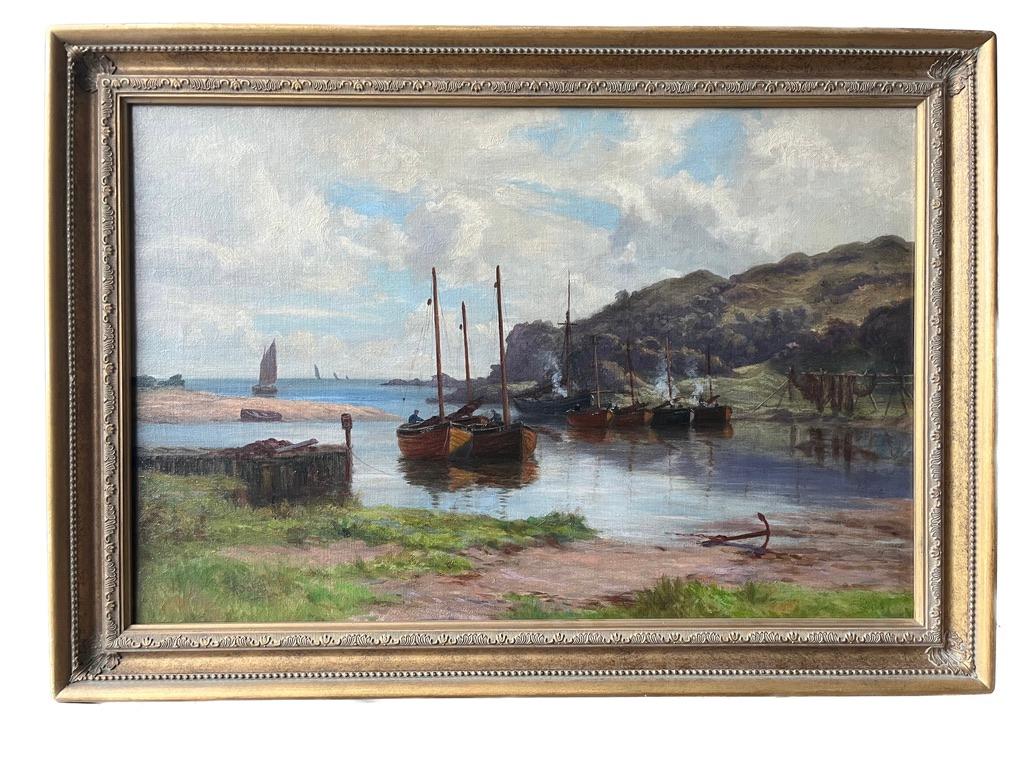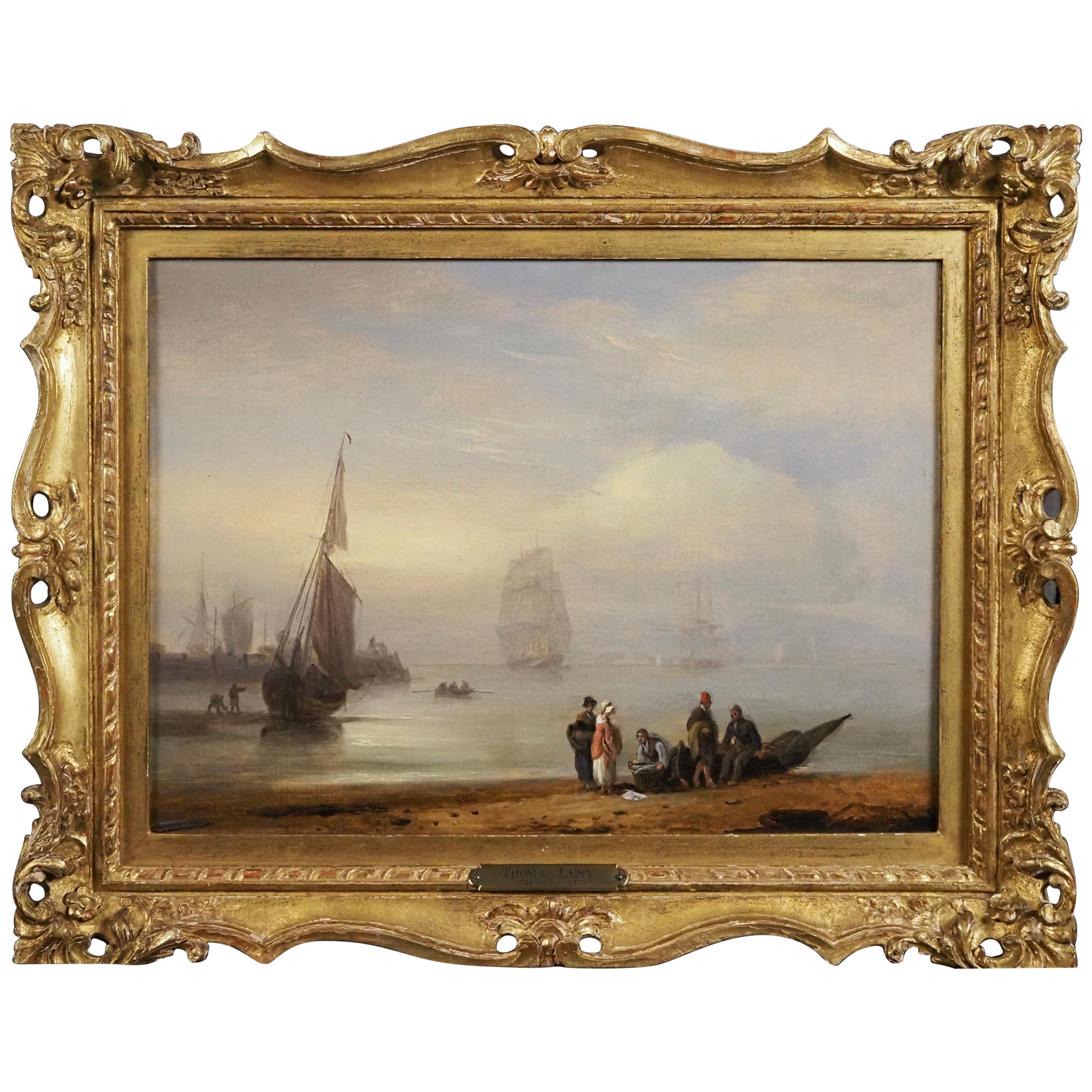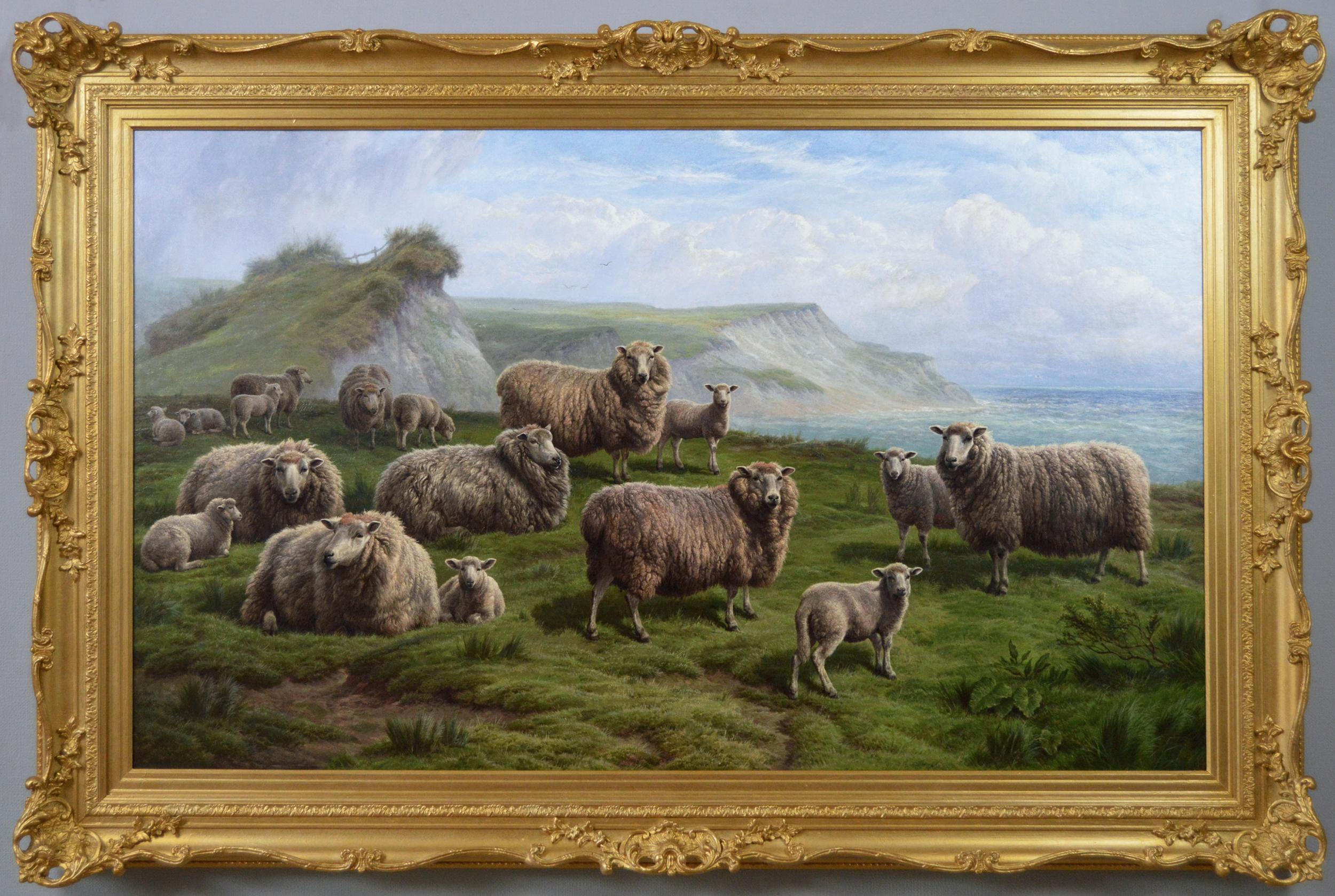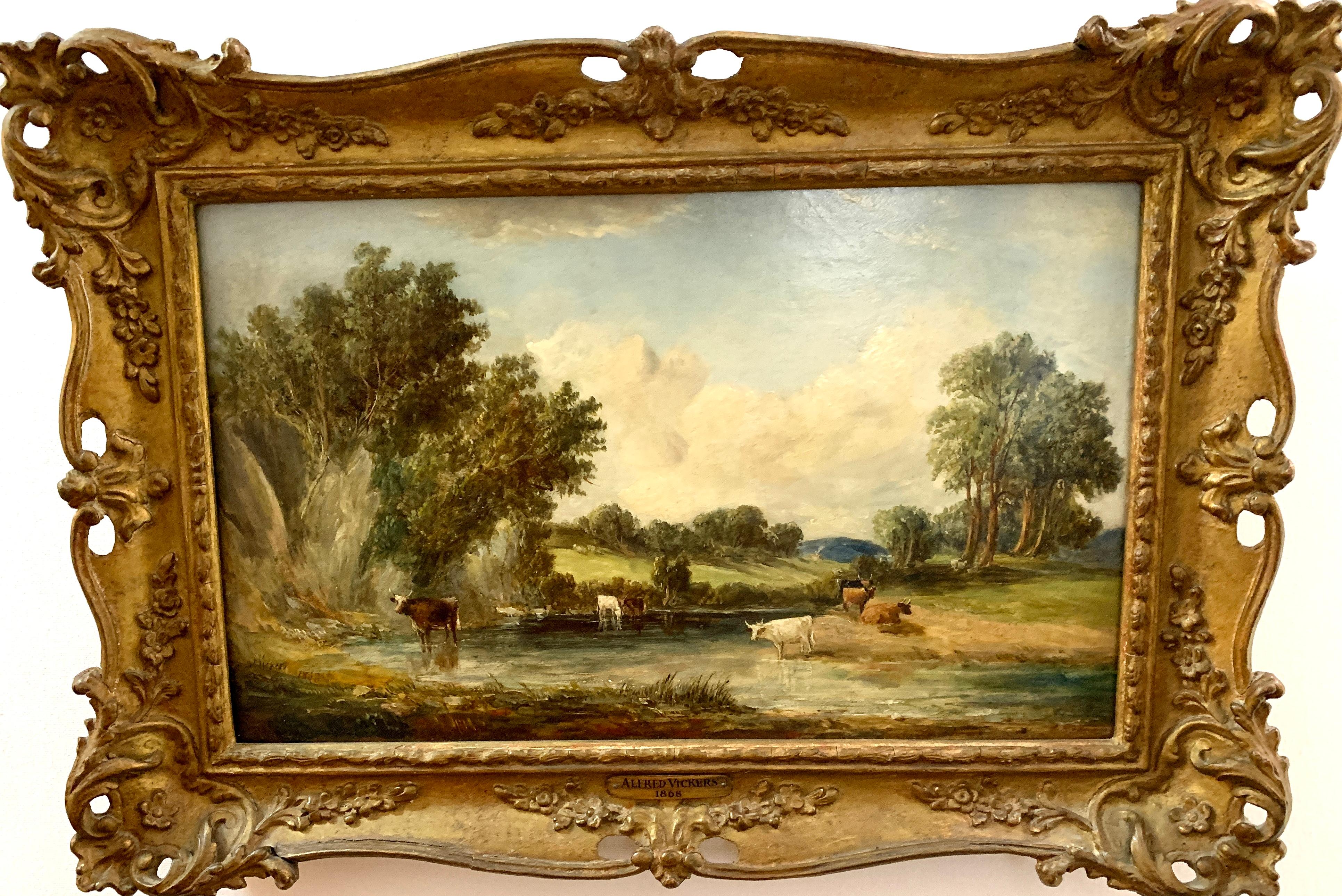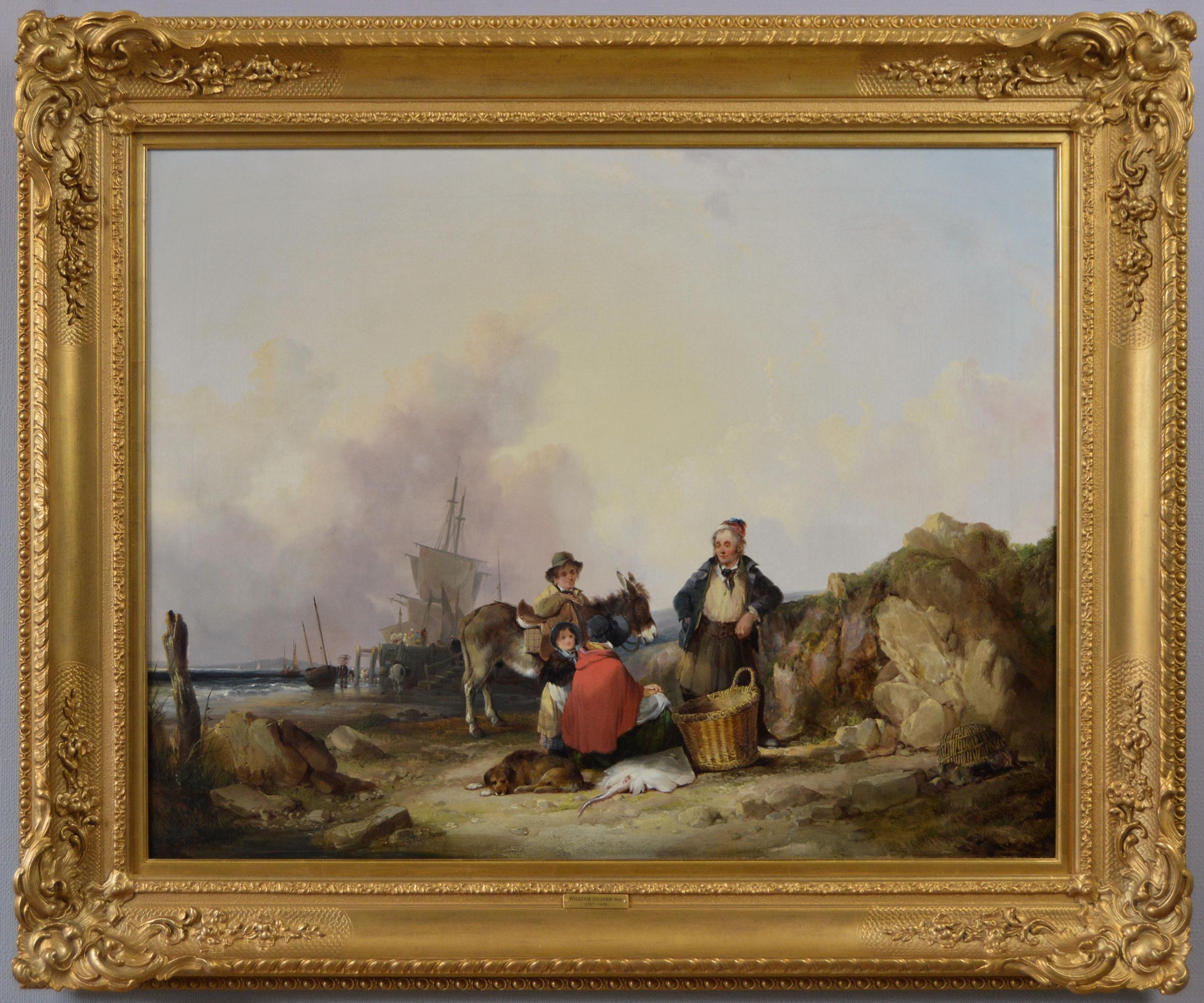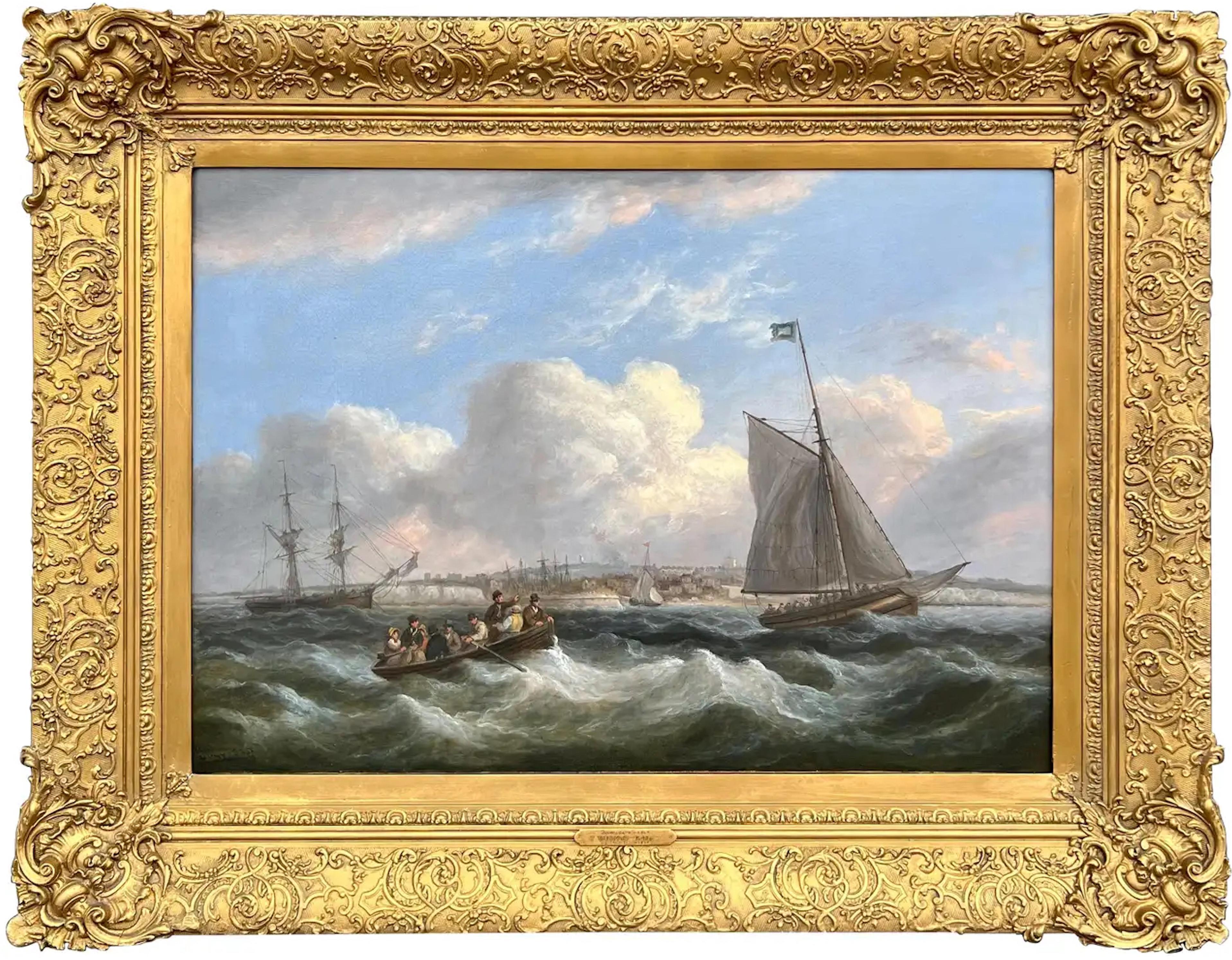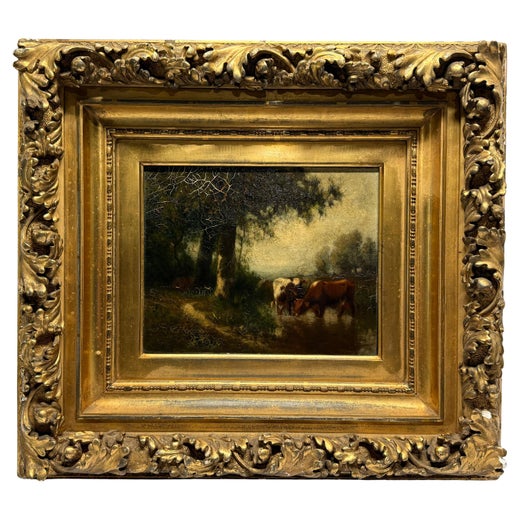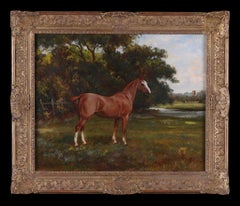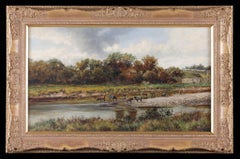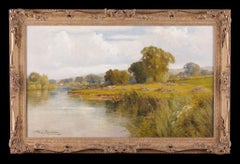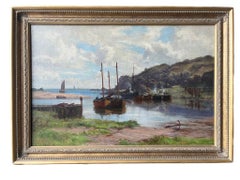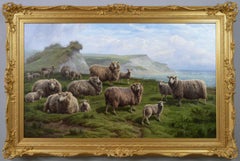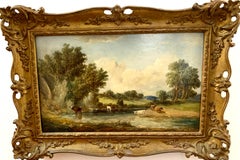Items Similar to Windsor Castle from the River Thames. An antique oil painting
Want more images or videos?
Request additional images or videos from the seller
1 of 10
William HartWindsor Castle from the River Thames. An antique oil painting1852
1852
About the Item
William M. Hart
American 1823 - 1894
Outside Frame Size: 36 x 49" (90 x 122cm)
Canvas Size: 28 x 41" (70 x 102)
Provenance: H.V. Allison Galleries, New York
Born in 1823 in Paisley, Scotland, William Hart emigrated with his parents to the United States at the age of nine and settled in Albany, New York. It was here that Hart first began his artistic training when he was placed under the tutelage of Messrs, Eaton & Gilbert, the prestigious coach-makers from Troy, New York. During this time, Hart learned how to decorate coach panels, covering them with either landscapes or figurative compositions. At the age of seventeen, he was eagerly contemplating an artist’s profession. Consequently, he left the mechanical trade of coach-making and began expanding his artistic pursuits to more refined endeavors.
Hart followed coach-making with decorating window shades and later developed an interest in portraiture. Around 1840, he established his first formal studio in his father’s woodshed in Troy. There, he created many likenesses of individuals, affording him a nominal income. Once, he remarked that he felt prouder over his first fee of five dollars for painting a head then for the larger sums he would command later in his career. Nevertheless, his wages from portraits during this early period proved insufficient. Thus, he expanded into landscape painting, allowing him to barter his works or sell them for modest prices.
In 1842, Hart moved to Michigan in an attempt to further his success; portraiture remained his primary means of support. Unfortunately, his experiences in the West were disappointing. Hart spent three years living a rough existence until he finally returned to Albany in 1845. Upon his return, he fully devoted himself to the art of landscape painting. Despite his failing health, he worked diligently to perfect his skill until 1849 when he traveled abroad to his native land of Scotland. This trip was made possible through the generosity of his patron and advisor, Dr. Ormsby of Albany. For three years, he studied in the open-air, creating brilliant sketches of the Scottish Highlands and the surrounding British Isles.
Returning to Albany once more in 1852, Hart enjoyed improved health and was reinvigorated with purpose. The following year, he moved to New York and opened a studio, promoting himself as a specialist in landscape painting. Hart became a regular contributor to the National Academy of Design. His works received a great deal of attention from artists and connoisseurs alike, all of whom praised him for his fresh, self-taught style. In 1855, he was designated as an associate of the National Academy of Design; three years later he was elected to Academician. In 1865, he was unanimously chosen to be the first president of the Brooklyn Academy of Design. It was during his tenure there that he delivered his famous lecture The Field and Easel, which emphasized the distinguishing principles of landscape art in America. Hart argued that landscape painters should express the “look of the place” being depicted. Critics during the 1870s noted his sensitive balance between capturing a strict “real” interpretation of nature and that of a more “ideal” sentimental tone. For instance, in 1869, Putnam Magazine noted that Hart brought back “exquisite studies” of the surrounding Tappan Zee area that were both well executed and full of artistry.
In the 1870s and ’80s, Hart continued to receive much public attention. Earl Shinn noted in an 1876 review of Hart’s work his distinct use of color, stating: "He loves to struggle with one of the most difficult feats of landscape-painting, the dazzling tints of our forests in autumn. His pictures of those mounds of leafy bloom which the Adirondacks yield in November are veritable bouquets of florid color."
Consequently, Hart’s landscapes graced both auction houses and many of the largest collections during the latter half of the 19th century. Furthermore, Hart’s demand during this period is evidenced in the many engravings of his paintings for gift books and art journals, including 13 works which were featured in Picturesque America, the most popular of such publications of the 1870s.
Museum Collections:
Albany Institute of History and Art, Albany, NY
Cleveland Museum of Art, Cleveland, OH
Currier Gallery of Art, Manchester, NH
Figge Art Museum, Davenport, IA
Fine Arts Museums of San Francisco, San Francisco, CA
Harvard University Art Museums, Cambridge, MA
Indianapolis Museum of Art, Indianapolis, IN
Metropolitan Museum of Art, New York, NY
Mildred Lane Kemper Art Museum, St. Louis, MO
Museum of Fine Arts, Boston, MA
National Academy of Design Museum, New York, NY
National Gallery of Art, Washington, D.C.
Philadelphia Museum of Art, Philadelphia, PA
Phoenix Art Museum, Phoenix, AZ
Samuel Dorsky Museum of Art, New Paltz, NY
Smithsonian American Art Museum, Washington, D.C.
Terra Foundation for American Art, Chicago, IL
Provenance: H.V. Allison Galleries, New York
- Creator:William Hart (1823 - 1894)
- Creation Year:1852
- Dimensions:Height: 36 in (91.44 cm)Width: 49 in (124.46 cm)Depth: 3 in (7.62 cm)
- Medium:
- Movement & Style:
- Period:
- Condition:The original frame is in good condition with natural wearing of the gold leaf.
- Gallery Location:St. Albans, GB
- Reference Number:1stDibs: LU2469214420522
William Hart
Born in Scotland, William Hart emigrated with his family to New York on the ship Camillus in 1830. He became known for serene, bucolic and romantic landscapes. Many of his paintings had cattle and realistic figures diminished in the landscape, a motif he began in the late 1880s. Hart was a second generation "Hudson River School" painter. George Inness and Asher Durand were major influences, although he was basically self-taught.
About the Seller
5.0
Gold Seller
Premium sellers maintaining a 4.3+ rating and 24-hour response times
Established in 1965
1stDibs seller since 2023
31 sales on 1stDibs
Typical response time: <1 hour
- ShippingRetrieving quote...Shipping from: St. Albans, United Kingdom
- Return Policy
Authenticity Guarantee
In the unlikely event there’s an issue with an item’s authenticity, contact us within 1 year for a full refund. DetailsMoney-Back Guarantee
If your item is not as described, is damaged in transit, or does not arrive, contact us within 7 days for a full refund. Details24-Hour Cancellation
You have a 24-hour grace period in which to reconsider your purchase, with no questions asked.Vetted Professional Sellers
Our world-class sellers must adhere to strict standards for service and quality, maintaining the integrity of our listings.Price-Match Guarantee
If you find that a seller listed the same item for a lower price elsewhere, we’ll match it.Trusted Global Delivery
Our best-in-class carrier network provides specialized shipping options worldwide, including custom delivery.More From This Seller
View AllWaves Crashing along the Beach. Antique marine painting Oil on Canvas
By Laurits Bernhard Holst
Located in St. Albans, GB
Lauritz Holst
Exhibited 1878 - 1926
Picture Size: 16.5 x 29" (41.25 x 72.5cm)
Outside Frame Size: 22.5 x 35" (56.25 x 87.5cm)
He was born in Bogense, Denmark in 1848
Holst was a m...
Category
1880s Victorian Landscape Paintings
Materials
Oil
A Horse in a Field. Oil on Canvas
By Wright Barker
Located in St. Albans, GB
Wright BARKER
1864 - 1941
Canvas Size: 24 x 30" (61 x 76cm)
Outside Frame Size: 31 x 37" (79 x 94cm)
Oil on Canvas
Free Shipping
Exhibited : 1885 - 1935
He was a figure and animal painter who was based originally in Bradford, where he lived until 1885, when he moved to Edwinstowe, near Mansfield, Nottingham. In 1901 he moved to Hampstead and then back north to Harrogate where he stayed until his death. In his later years he became a picture dealer, but in his will he referred to himself as ‘animal painter’.
Barker became a member of the Royal Society of British Artists in 1896. Although he called himself an animal painter he is also known to have painted ‘Roman Maidens...
Category
Early 1900s Victorian Animal Paintings
Materials
Oil
Cattle Grazing Near Rhyl, North Wales
Located in St. Albans, GB
A stunning, showpiece example of William Henry Mander's painted in Rhys, North Wales. The size is unusual and perfect for a mantlepiece as a statement piece.
Picture Size: 22 x 36" ...
Category
1880s Victorian Landscape Paintings
Materials
Oil
Working in the Hayfields
Located in St. Albans, GB
Harry Pennell
Picture Size: 24 x 40" (61 x 102cm)
Outside Frame Size 31 x 47" (79 x 120cm)
Exhibition Period 1900 – 1930
Harry Pennell (1879-1934) was a British artist and illustr...
Category
Early 1900s Victorian Landscape Paintings
Materials
Oil
$3,476 Sale Price
20% Off
A Conversation by the Bridge
Located in St. Albans, GB
David Bates
A very traditional English oil painting by the highly collected artist David Bates.
It is in a gold leaf swept frame
Canvas Size: 24 x 36" (61 x 91cm)
Outside Frame Size...
Category
1890s Victorian Landscape Paintings
Materials
Oil
Working in the Hayfields
Located in St. Albans, GB
HENRY H. PARKER
Picture Size: 20 x 30" (50 x 76cm)
Outside Frame Size: 27 x 37" (67.5 x 92.5cm)
Free Shipping
A typical example of Henry Parker's work. Parker is a highly collecte...
Category
Late 19th Century Victorian Landscape Paintings
Materials
Oil
You May Also Like
Victorian landscape painting of Scottish fishing boats moored in a bay
Located in Harkstead, GB
A very tranquil scene of fishing boats moored in harbour with a sunlit sea beyond. Painted with a most attractive palette of blues and greens and with a pleasing composition that le...
Category
19th Century Victorian Landscape Paintings
Materials
Canvas, Oil
$1,792 Sale Price
28% Off
A fishing vessels at rest in harbour
By Thomas Luny
Located in Stoke, Hampshire
Thomas Luny (1759-1837)
A fishing vessels at rest in harbour
Signed and dated 'Luny 1831' lower left
Oil on canvas
Canvas Size - 12 x 16 in
Framed Size ...
Category
19th Century Victorian Landscape Paintings
Materials
Oil
19th Century exhibition size landscape oil painting of Sheep on a cliff
By Charles Jones (b.1836)
Located in Nr Broadway, Worcestershire
Charles Jones
British, (1836-1892)
Sheep Resting
Oil on canvas, signed with monogram & dated 1877, further inscribed verso
Image size: 35 inches x 59 inches
Size including frame: 47 inches x 71 inches
Exhibition Size Painting
A fantastic exhibition sized landscape painting of sheep on a cliff top by the coast by Charles ‘Sheep’ Jones. At the time he produced this painting, Jones was living at Heathercroft, Balham Hill in London. Given the size and quality of the work it was most likely an exhibition piece. The topography and landscape suggest that this is the Dorset coast, one of his favourite places to paint.
Charles Jones was an animal painter who was born in Stepney, London in 1836. He was the son of the artist Samuel John Egbert Jones (1797-1861) and Dinah Jones. He lived with his parents and 9 siblings in Mile End and was a pupil of his father. In September 1859, he married Frances Rosalinda Downe, who was born in America. His son Arthur Bertram Loud (1863-1930) also became an artist. They lived at 12 Hayes Place, Lisson Grove from where he made his debut in London at the Royal Academy in 1861. He also exhibited at the British Institution, Suffolk Street, New Watercolour Society, Royal Institute of Oil Painters and the Royal Institute of Painters in Watercolours.
By 1867, he had become a successful artist and they had moved to 7 Paragon Place, Brixton Hill. From 1874 he lived at Heathercroft, Balham Hill where he spent the rest of his life. Jones became well known for specialising in paintings of sheep, cattle and deer in landscape settings. He spent his time travelling around visiting areas such as Devon, Dorset, Kent, Sussex and the Highlands. However, it is for his skilful painting of sheep that he is perhaps best known, and for which earned him the nickname of ‘Sheep’ Jones.
As well as the major London galleries, he also exhibited provincially at various locations including: the Royal Cambrian Academy where he was elected a member in 1886, the Glasgow Institute of Fine Arts, Manchester City Art Gallery, Royal Hibernian Academy, Royal Society of British Artists, Birmingham and the Walker Art Gallery, Liverpool. Some of the smaller more intimate galleries he exhibited at were Arthur Tooth & Sons and Thomas...
Category
19th Century Victorian Animal Paintings
Materials
Canvas, Oil
19th century English Antique oil landscape with cows resting by a river
By Alfred Vickers
Located in Woodbury, CT
A stunning 19th century English Antique oil landscape with cows resting by a river.
Alfred Vickers was a painter of marine subjects and landscapes. He exhibited extensively througho...
Category
1860s Victorian Landscape Paintings
Materials
Oil, Canvas
$3,600 Sale Price
20% Off
Free Shipping
19th Century genre oil painting of fisher folk on a beach
By WILLIAM SHAYER SENIOR (1787-1879)
Located in Nr Broadway, Worcestershire
William Shayer
British, (1787-1879)
Fisher Folk on the Beach
Oil on canvas, signed & dated 1839
Image size: 27.25 inches x 35.25 inches
Size including frame: 37.25 inches x 45.25 in...
Category
19th Century Victorian Figurative Paintings
Materials
Canvas, Oil
Shipping Off the Coast
By Thomas Luny
Located in Wiscasett, ME
Shipping off the coast by English artist Thomas Luny. Oil on canvas signed and dated 35' in the lower left. Nice period and possibly original frame.
Thomas Luny (1759–1837), born in Cornwall, probably at St Ewe, was an English artist and painter, mostly of seascapes and other marine-based works. At the age of eleven, Luny left Cornwall to live in London. There he became the apprentice of Francis Holman, a marine painter who would have a great and long lasting artistic influence on Luny: Luny remained until 1780 in Holman's London studio, which, was first situated in Broad Street, St. George's, and later relocated to Old Gravel Lane. Examples of his work are exhibited at the National Maritime Museum at Greenwich, in the Royal Albert Memorial Museum in Exeter, and at The Mariners' Museum in Newport...
Category
1830s Victorian Landscape Paintings
Materials
Oil
Recently Viewed
View AllMore Ways To Browse
Studies For Paintings Antique
Castle Antiques
The Real Deal
William Castle
Castle Engraving
Paisley Art
Painting Oil Earl
Windsor Castle
Scotland Castles
Scottish Castle
Antique Frames Philadelphia
H Frame Easel
Antique American 19th Century Portrait
Antique American History Books
Antique Advisor
1850 Portrait American
Victorian Mechanical
American Victorian Portrait Painting
